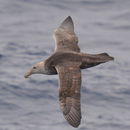Biology
(
英語
)
由Arkive提供
Southern giant petrels are largely scavengers, and feed mainly on seal and penguin carcasses, offal, refuse from ships and discarded fish (2) (5). They often feed close to trawlers and vessels fishing with longlines (2). They also prey upon penguins and other birds, krill and amphipod crustaceans, fish and squid. During chick rearing, they depend heavily on penguins and seal colonies, as a food resource (5).
During the breeding season, loose colonies form at the breeding sites (2). During October or November, pairs lay a single large egg into a low cup-shaped nest made of grass, moss and gravel. The eggs are incubated for 55 to 66 days (6). The chick remains in the nest until it fledges towards the end of March. Giant petrels are very susceptible to disturbance during the breeding season, and tend to abandon the nest if they are threatened (4). Petrels are able to regurgitate foul-smelling oil which they spit at intruders; this habit earned the southern giant petrel the alternative name of 'stinker' (7).
After fledging, juvenile birds spend their first two or three years of life at sea on an extensive migration, in which they circumnavigate the Southern Ocean. Although this species may begin to breed at four years, most individuals begin to breed between six and ten years of age (5).
Conservation
(
英語
)
由Arkive提供
The southern giant petrel is listed under Appendix II of the Convention on Migratory Species (CMS). Monitoring programmes are underway at several locations and a number of its breeding colonies occur within nature reserves and World Heritage Sites. Proposed measures include continued monitoring, surveys of all of the major breeding sites and minimisation of disturbance at the breeding colonies. Furthermore, it has been suggested that all fisheries operating within the range of this species should adopt best-practice guidelines to minimise the risk of accidental by-catch of this petrel (2). As a result of this mitigation, populations of this magnificent bird around the world are now slowly increasing (8), and its IUCN Red List status has been amended to Least Concern (2).
Description
(
英語
)
由Arkive提供
The southern giant petrel is, as the name suggests, a very large bird, with impressive long, pointed wings and a huge bill (2). Like all species of petrel, this bird has tubular nostrils that are united at the top. There are two colour forms of this species: a rare white form that is flecked with black and a dark form with mottled greyish-brown feathers with a paler belly. In this dark form, the head, neck and upper area of the breast whitens with age (2). The sexes are similar and juveniles are sooty-black in colour (2) (4). All age groups have a large yellowish bill with a green tip, capable of opening intact carcasses (2) (3). This petrel is of a similar size to albatrosses, but it can be distinguished by its large bill, narrower shorter wings and a general humpbacked form (2).
Habitat
(
英語
)
由Arkive提供
This petrel is pelagic and nests in colonies on islands. Breeding colonies are found on bare or grassy ground (2), often close to penguin colonies (5).
Range
(
英語
)
由Arkive提供
Southern giant petrels are circumpolar in distribution. The breeding colonies are found from the sub-Antarctic islands south to the Antarctic continent (5).
Status
(
英語
)
由Arkive提供
Classified as Least Concern (LC) on the IUCN Red List (2). Listed under Appendix II of the Convention on Migratory Species (CMS) (2).
Threats
(
英語
)
由Arkive提供
Between 1997 and 1998, an estimated 2,000 to 4,000 southern giant petrels were killed in illegal and unregulated longline fisheries for Patagonian toothfish in the Southern Ocean (2). Other threats include a decline in the population of the southern elephant seal Mirounga leonine (an important source of carrion for the petrel), increasing disturbance by humans and persecution (2).

